Nestor's cave
This cave is shrouded in history and mythology, and it sits high above the beautiful Voidokoilia Beach. We know it was used by our ancestors way back in the Neolithic period, but did the fabled King Nestor really keep his cattle there? And what about Hermes – mythology tells us he used it to hide the oxen he had stolen from the god Helios.
This historic cave is in a location with great views, above Voidokoilia beach and to the north west of the Palaiokastro (or Old Navarino Fortress). Unfortunately, it is not open to visitors, but it’s still interesting to learn something about it. Nestor was a king of Pylos and one of the most famous heroes in Homer’s epics. The Greek traveller Pausanias’ description tells us that the whole area around Voidokoilia is connected to Homer’s Pylos and the two kings Neleus and Nestor, a theory which many scholars agree with. Pausanias also tells us that there was a city inside the cave –and that the cave was used as the stables for the two kings’ cattle. It seems to have been quite a good place to use as a stable, as in Greek mythology Hermes used it to hide the oxen he stole from the god Helios.
The entrance of the cave can be seen from afar. The main chamber has a vaulted ceiling about 20 m high but is not particularly deep. The rocks are mainly limestone and have a "Gothic look", according to professor and archaeologist Spyros Marinatos.
The cave was first used in the Neolithic period and samples of pottery from the 6th and 5th millennium BC have been found here. It was then used more sporadically in the Early Helladic period (3rd millennium BC), and then more intensively in the late Middle Helladic and Mycenaean period (2nd millennium BC). During the Geometric period and Late Classic times, it was used less and less.
It is thought that people used it as a place of worship - something that makes sense given the number of settlements and burial places found in the wider area around Voidokoilia.
Heinrich Schliemann, who famously excavated Mycenae and Troy, carried out an initial exploration of the cave in 1874 as he was looking for signs of Homer’s Kingdom of Nestor near here. A few further limited excavations were carried out in the early 20th century and in 1980 Nestor's cave was explored by the University of Athens and the Athens Archaeological Society.
Location
Find the destination on the interactive map below.
Σχετικό περιεχόμενο χρηστών (UGC)
Ενημερωθείτε για ενδιαφέροντα θέματα γύρω από τον προορισμό μέσα από το περιεχόμενο των χρηστών μας
Discover 7 hidden gems of the Peloponnese
Many of you may have already visited some of the most renowned attractions…
TOP 10 archaeological museums in the Peloponnese
Olympia, Mycenae, Epidaurus, Diros Cave, Ancient Corinth, Messene and…
TOP 10 Castles in the Peloponnese
Castles galore! Mystras, Monemvasia, Palamidi, Methoni, Koroni,…
Newsletters
- About us
- FAQ's
- Map
- Tourism information centers
- Disclaimer
- Sitemap
- Our brand
- Media roum
- Adding your bussiness
- Corporate
- MICE

Peloponnese. Greece beyond the obvious





Design and creation from Cosmote
Marinas and Moorings
Diving centers
Get inspired
- Media gallery
- Blog
- The Peloponnese in the media
- Your feedback
- Users' general content
- Users' local products
- Users' events content
- Ask a local
More
- Accommodation
- Travel agencies
- Restaurants
- Services
- Destinations Map
- Weather
- Public transport
- Events
- Frequently asked questions
- Useful phones
- B2B
- Destination Data
- Contact

